COVID-19 has kept medical science liaisons grounded for more than a year. In response, they’ve been busy mastering the art of the digital connection to continue delivering crucial scientific information to healthcare practitioners and key opinion leaders.
Our experts agree the role of the medical science liaison (MSL) has never been more vital as during the COVID-19 pandemic. Healthcare practitioners (HCPs) and key opinion leaders (KOLs) alike continue to turn to MSLs to help them make sense of the constant flood of information about research into vaccines and therapies for COVID-19 and the SARS-CoV-2 virus that causes it.
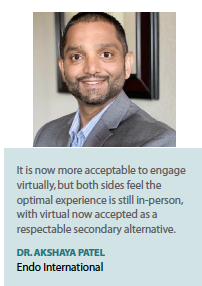
“Now, more than ever, we are seeing a need for MSLs to be able to answer questions about COVID vaccines, timing of vaccines, and therapies,” says Christina Hoffman, global head, Medscape Medical Affairs. “Manufacturers of COVID vaccines and/or therapies are providing this information to all of their teams, as COVID is not limited to certain disease states. Moreover, companies without COVID vaccines and/or therapies in their pipeline are moving to create medical information and other approved sources of information to inform physicians of how COVID considerations may impact the clinician’s ability to treat patients. This will likely not change in the foreseeable future.”
Eliav Barr, M.D., global medical and scientific affairs at Merck, says the company’s field medical staff supported scientific leaders during periods of highest stress by helping them find answers to COVID-related questions relevant to their specialty. “Once scientific leader access opened up again, we were able to help them catch up on our research programs and new data when requested,” he says.
Rohit Gupta, VP of analytics strategy and transformation at Beghou Consulting, sees interactions between MSLs and HCPs or KOLs as having become more reactive amid the pandemic. “When KOLs call on MSLs, their requests for scientific information have become much more specific — for instance, wanting answers related to COVID, rather than the therapeutic areas they may have discussed pre-COVID,” Mr. Gupta says.
KOLs are also expecting MSLs to give them this information in a more curated fashion. “They don’t want a blizzard of information,” Mr. Gupta says. “The MSL needs to make the information easy for KOLs to consume while building rapport through the kind of help they provide.”
The Year of Living Virtually
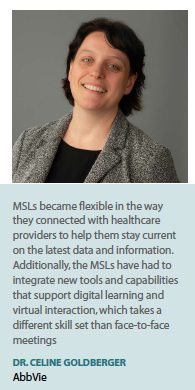
Bruno Larvol, founder and CEO of Larvol, believes COVID-19 has challenged the very makeup of the traditional MSL role, having transformed it overnight from a typically social role involving lots of travel and face-to-face interaction into a solitary, primarily digital job.
“During COVID-19, MSLs have had to get tech-savvy quickly,” Mr. Larvol says. “From video calls to virtual conferences to social media, many MSLs have had to upskill their tech comfort on the fly or be left behind.”
MSLs also were tasked with building rapport without the help of proximity. “Each new platform has presented a new challenge for connecting effectively with HCPs,” Mr. Larvol says. “MSLs have had to master proper ‘Zoom etiquette’ and learn to translate their personality and expertise confidently through a screen.”
Akshaya Patel, Pharm.D., head of field medical affairs at Endo International, says the switch to virtual engagement was initially disconcerting for both MSLs and their audience.
“Over time, HCPs/KOLs and MSLs have accepted the ‘new normal’ and have seen benefits to the changes,” Dr. Patel says. “However, they also have recognized what was lost, even though it was believed to be temporary. It is now more acceptable to engage virtually, but both sides feel the optimal experience is still in-person, with virtual now accepted as a respectable secondary alternative.”
While it’s true MSLs have traditionally interacted in person with HCPs and KOLs, Robin Winter-Sperry, M.D., global field medical lead, Ipsen, says they have long been used to working independently out of a home office as part of a virtual team. “COVID has certainly improved our digital acumen and accelerated the development of many of our tools,” she says. “It has increased skills for digital interactions over various channels. COVID has also driven an acute change to the extent of virtual engagements and provided thought leaders with the ability to request more individualized and flexible — sometimes on-demand — approaches to interacting with them.”
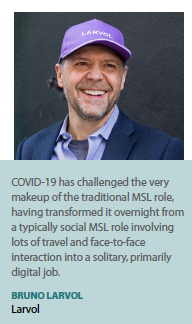
This shift has prompted MSLs to think outside the traditional meeting box. “Without travel time to factor, opportunities for meetings expanded,” Mr. Larvol says. “MSLs could rethink the timing, length, and type of interactions with HCPs, considering shorter calls, possibly after hours, or over the weekend.”
Dr. Barr says moving to a completely virtual environment was initially difficult for Merck’s field medical teams, but they adapted quickly and have become adept at conducting scientific exchange virtually.
“It is important to understand the scientific leader’s preferred method of virtual engagement, whether email, text, phone, WebEx, or video,” he notes.
According to Dr. Barr, going virtual means MSLs spend less actual time in discussion with the HCP or KOL. Most virtual engagements last 15 to 30 minutes as opposed to face-to-face engagements, which often lasted close to an hour. But with that shortened time comes greater efficiency. Virtual meetings tend to be much more direct and to the point, removing the informal dialogue that takes place in face-to-face engagements. Also, with virtual meetings, there tends to be less waiting and more flexible scheduling.
On the downside, Dr. Barr observes, virtual meetings seem to set a more formal atmosphere for meetings and can sometimes impair the free-flowing, organic scientific exchange that occurs more naturally with face-to-face meetings.
“The biggest obstacle to engaging scientific leaders remains among those that the field medical team members have never met,” he says. “Establishing scientific credibility and building a relationship over a WebEx or Zoom call is a slower process. As far as permanence, I imagine that some scientific leaders will request some component of virtual interaction in the future, even those who were originally resistant.”
Jennifer Millard, VP, field medical affairs & market access deployment services for IQVIA, says MSLs’ shift to virtual engagement with thought leaders isn’t so much a new trend as one that was further accelerated by the COVID-19 pandemic.

“This provides pharmaceutical companies an opportunity to re-envision field force activities, including those of MSLs,” Ms. Millard says. “Interactions need to be valuable and personalized to the thought leader to have true impact. In-person engagements will never be completely replaced, but virtual and digital interactions provide an opportunity to maximize the meetings and exchanges with thought leaders.”
“The pandemic increased the speed in which medical affairs needed to create digital educational resources across multiple channels,” says Celine Goldberger, M.D., Ph.D., VP, head of U.S. medical affairs for AbbVie. “MSLs became flexible in the way they connected with healthcare providers to help them stay current on the latest data and information.
Additionally, the MSLs have had to integrate new tools and capabilities that support digital learning and virtual interaction, which takes a different skill set than face-to-face meetings.”
As is the case in many life-sciences roles, Ms. Hoffman says COVID has forced MSLs to demonstrate their value in a virtual space, whether in real time or via some asynchronous options such as email or on-demand presentations.
“Conducting discussions via remote tools is more often the norm versus the exception it was before COVID,” Ms. Hoffman says. “As U.S. vaccination rates remain lower than anticipated and new strains of COVID-19 spread globally, there will be a continued tension between conducting face-to-face meetings and maintaining pandemic restrictions, especially in hospitals and doctor’s offices where immunocompromised or highly vulnerable patients are present.”
Scott Thompson, co-CEO of Acceleration Point, says while it’s obvious many MSL interactions with KOLs have moved to virtual, the part that’s been less apparent is the increased scrutiny KOLs are placing on whether they’ll choose to engage with MSLs regardless of platform.
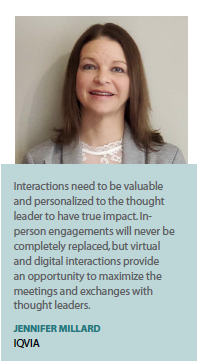
“The pandemic has eliminated the ‘I am going to be in town and it would be great to see you’ opportunities,” Mr. Thompson says. “MSLs are going to need relevant content to discuss and do a great job of looking for triggers to engage.”
Michael Melucci, med ed lead at Ogilvy Health, says one thing the pandemic hasn’t changed is the willingness of HCPs to give their time to MSLs.
“HCPs and thought leaders have told us they’re more open to having the conversation with MSLs because they know in that 15 to 20 minutes they might give the MSLs, they’re going to get the info and data that they want from the scientific liaison in a short period of time, ” Mr. Melucci says.
Different Venues, Same Goals
Amid all the changes sparked by the pandemic, Dr. Patel says the goals of the MSL have remained the same. “Their focus areas continue to be excellence in scientific communication and engagement, with the objective of advancing disease awareness and patient care and being an educational and scientific resource to the medical community at large, and specifically to HCPs and KOLs that are therapeutically aligned,” he says. “What has changed are the working solutions to achieve objectives and goals using all available technology platforms to sustain existing relationships and even develop new ones in the absence of in-person communication and scientific exchange.”
According to Dr. Winter-Sperry, that strategic focus should be just as focused on in-depth scientific exchange with regional thought leaders as with the community at large. “MSLs have their finger on the pulse of their local healthcare environment and represent the voice of HCPs back to the company,” she says.
At Merck, Dr. Barr says, the field medical teams are tasked with obtaining insights on the standards of care, unmet medical needs, and emerging data within the relevant disease area, as well as answering questions regarding emerging data with the company’s assets or those of competitors. Also, the teams can connect the scientific leaders with Merck’s research teams when necessary.
“To be effective, MSLs must establish themselves as credible and trusted colleagues that can help the scientific leader navigate the company’s research infrastructure and provide, in response to questions, contextualized, accurate, objective, and balanced information regarding the company’s research programs,” he says.
“During this stressful year, many scientific leaders could no longer attend virtual conferences or even get through the data in a timely way,” Dr. Barr adds. “A highly professional MSL really shines here as he or she is in a unique position to deliver what scientific leaders want and need concisely and in a timely fashion.”
Dr. Goldberger says it’s important for MSLs to be agile and resourceful, adapting to the changing environment while still being able to ensure healthcare providers receive the information they need to provide the best care for their patients.
“One of the main reasons that MSLs are so valued by clinicians is that they can have those intellectually stimulating conversations and bring light to valuable information that can serve to improve a thought process or patient care in the end,” Ms. Hoffman says. “In the end, none of that has changed, only the ways in which it is done have.”
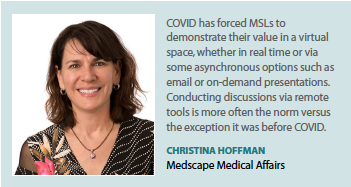
Mr. Melucci agrees that the objectives of the MSL are unchanged, but says the way in which they deliver the information has had to evolve.
“What they’ve had to do, just as we’ve all had to do, is craft their content in a shortened, easier fashion,” he says. “They know in this virtual world they’re not getting hours with the physician; they won’t be at full-day meetings or advisory boards talking with physicians. So, they’ve needed to streamline their content by focusing on what are the most important messages and key data the physician needs to hear about the product.”
As the importance of MSLs has increased, Mr. Melucci says more of Ogilvy Health’s commercial clients have been requesting to speak to the medical affairs team about how the MSLs can get the client’s scientific information out.
“They’re requesting more information and more touch points,” he says. “I do think that will continue. That’s a good thing for MSLs in terms of necessity and ensuring you have strong scientific and strategic speakers on your behalf. It is important to utilize these pharma partners as they are the group that gets in the door of the targeted physicians.”
According to Mr. Larvol, MSLs remain the backbone of the pharma industry, connecting pharma and HCPs at the ground level. And while he doesn’t see their goals changing any time soon, they will have to employ very different tools and skill sets to reach HCPs in the digital space.
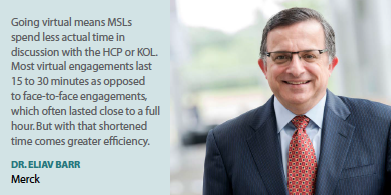
“I see two key objectives for today’s MSL,” he says. “One is to non-promotionally engage in a productive scientific conversation with the HCP in a way that is mutually beneficial to the HCP and the MSL’s employer. Two is to listen and learn from the HCP to better understand the unmet medical needs, standard of care, and the positioning of competing products.
“Both goals require a genuine rapport between the MSL and the HCP, built on respect for the MSL’s scientific knowledge, intellect, and personal connection,” Mr. Larvol continues. “To build that peer relationship, MSLs need to take advantage of all the opportunities for connection — in-person, via video, and on social media.”
In addition to having to learn how to communicate data without meeting in person, Dr. Goldberger says MSLs have had to learn to work more efficiently and virtually with cross-therapeutic-area partners to deliver information to providers with expanded specialties.
Mr. Thompson says the decline in MSL travel seems to have led to excess capacity among many MSL teams. “Much of this capacity was taken up with learning and identifying innovative engagement strategies,” he says. “However, some teams found that MSL time has been taken up with internal projects. I do believe that as opportunities to engage increase that MSLs will turn their attention back to that priority.”
Part of the Team
The pandemic may have prevented MSLs from traveling and holding face-to-face meetings with thought leaders, but Ms. Millard says they have been able to support in-house medical affairs duties, refine soft skills, and prepare for meetings to enable more personalized exchanges of scientific information to enable insight generation. “While the overall objective of an MSL has not fundamentally shifted over the last year, companies are rethinking the optimal engagement model and how to measure against that,” she says. “A compliant partnership between medical affairs and commercial is more essential to further triage and coordinate field engagement to ensure improved customer engagement and experiences. The good news is that we have seen HCPs are receptive to innovations in scientific data, and MSLs are key to disseminating new science.”
By nature of their role, Dr. Winter-Sperry says, MSLs play a major part in raising the importance of medical affairs in organizations. “They work as a credible, trusted, scientific resource to the HCPs through the provision of evidence-based, fair, and balanced information to help HCPs make the most informed treatment decisions possible,” she says.
According to Mr. Gupta, MSLs also have had to reallocate some of their responsibilities to other support functions. “For example, medical information call centers have been experiencing heavier workloads in the form of inquiries for access, modern off-label uses, and such things,” he says. “As KOLs have become more familiar with the virtual setting, they’ve become more comfortable with calling these centers directly for information.”
Ms. Millard has seen this as well. “In some cases, MSLs have been able to support medical information call centers that have been experiencing higher volumes of inquiries,” she says. “These inquiries are often a reflection of the impact of the pandemic on patient access — for example, how to handle missed doses. The MSL supporting this function provides scientific insight into customer needs.”
“During the pandemic, a lot of the time that previously had been spent traveling was ‘recommissioned,’” Dr. Winter-Sperry says. “Many teams took advantage of this newfound time to provide additional support to other internal functional areas such as research and training. It gave many MSLs a chance to discover new growth areas both at work and at home. It has enhanced their ability to network in different creative ways along with bringing a new appreciation of the need for community and support. I think these changes are important and, while they may evolve further, are changes that are here to stay.”
Greater Expectations
Mr. Thompson says over the past year he has seen increased expectation around the plans MSLs are required to produce.
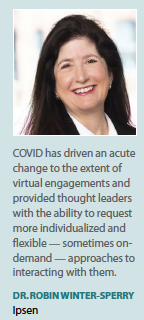
“While most great MSLs have always had a plan, they have not always been documented and collaborative across the medical function,” he says. “The increased access issues have required better planning and escalation of engagement responsibilities as needed across the medical affairs team.”
Mr. Larvol believes many MSLs are facing what he calls “the KPI comeback,” referring to key performance indicator (KPI) measurement.
“While grounded from any significant travel, there’s most likely been a greater emphasis on metrics,” he says. “Remote work naturally leads to this pressure. Logging digital meetings, tracking communications, and completing admin work in a CRM or engagement platform all represent a different set of tasks for experienced MSLs. I imagine that some teams may find these more-detailed metrics useful in the long run, and others may return to a greater focus on results.”
Mr. Gupta says he’s also observed a shift in the way KPIs are measured during the pandemic. “MSL goals aren’t measured on the outcome per se — they’re measured more on activity business,” he says. “Things like how many visits, the length of each visit, whether there was a second visit, did the key opinion leader engage with you to participate, and so forth. They are very much activity and input-based.
“During COVID, it wasn’t that these measures weren’t still being assessed, it was that they were being assessed in a more contextual way based on which geographies the MSLs were operating in,” he says. “For instance, in recent months some in-person meetings have resumed in certain areas, so the MSL team had to look at these KPIs as less of a benchmark and more in the context of where and how the MSL was able to conduct their meetings based on their geographical location.”
Mr. Gupta says the pandemic also has led to the introduction of additional qualitative KPIs, such as the ability to accommodate schedule changes and flexibility and, if the HCP or KOL preferred a phone call to a video chat, how effective the MSL was on a voice-only basis.
“Another important measure is the MSL’s ability to collaborate internally with other stakeholders who are interacting with those HCPs and KOLs, with the MSL playing more of a quarterback role,” Mr. Gupta says.
Making Virtual Scientific Meetings Work
One of the first things to go in the COVID-19 era has been the live, in-person scientific meeting. Events scheduled in the early months of the pandemic were cancelled outright, and those with more lead time were switched to virtual-only.
This was another major adjustment for MSLs, since scientific meetings play a key role in updating and expanding their medical knowledge, as well as maintaining their existing KOL relationships and forging new ones.
“Scientific meetings are a critical venue to interact with scientific leaders in real time and gauge their interest and questions about relevant data,” Dr. Barr says. “This is difficult to do at a virtual congress and much less effective on a follow-up meeting.
“It will be important to have these in-person medical meetings to enable the robust discussions that had occurred with external scientific leaders and internal company colleagues at congresses,” he adds. “This type of interaction is greatly appreciated and helps the MSLs have a broader perspective of the therapeutic area and Merck. Scientific congresses are also important for the continuing education of our field medical teams.”
Ms. Hoffman agrees that meeting people face-to-face at these events is always more impactful, especially if a clinician has made the time to go to a congress and sees it as facilitating staying current in their practice.
“The MSL being in that space at that time is essential to capture the learning and mind-open opportunity,” she says. “Virtual burnout is a very real issue, and as opportunities present themselves for safe face-to-face interactions, MSLs and their clinician partners will take full advantage of those opportunities.”
Unfortunately, Ms. Hoffman says, there have been few, if any, meaningful scientific congresses since the start of the pandemic. “Clinicians are very anxious to start getting back to those so long as they can be safe,” she says. “They want very much to have peer-to-peer interactions but don’t want to travel extensively and be in tight confined spaces with thousands of other people. The days of 3,000 people all live in a conference room watching a scientific late-breaker are likely over.”
“I think the one area that lacks from a congress and a medical meeting perspective when it comes to a virtual model is the reduced time MSLs have to spend and connect with opinion leaders,” Mr. Melucci says. “As we all know, there’s nothing more valuable than seeing a KOL on the floor of a congress at an in-person medical meeting and being able to grab them for five minutes and have a chat. Those are truly the invaluable minutes.
“I think this has become a real obstacle during the pandemic,” he adds. “The days of the one-on-one interviews we all conduct at congresses and medical meetings are really becoming more challenging when you can’t do them in person.”
Ms. Millard says MSLs have been able to overcome the challenges of the pandemic and continue to foster existing relationships with KOLs. “However, building new relationships has been especially difficult during the pandemic and heightened by cancelled or virtual scientific meetings,” she says. “The organic interactions that can often be found during in-person scientific meetings are becoming nearly impossible in a virtual environment. Most virtual conferences have implemented numerous digital techniques to keep audience members engaged, but nothing quite replaces live Q&A or an impromptu conversation at a company’s booth.”
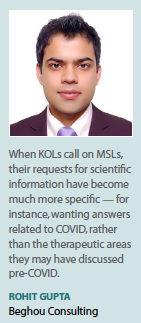
“Based on conversations with HCPs and KOLs over the course of the pandemic, the ability to separate from the distractions of the clinic and immerse with colleagues and industry leaders to listen and learn about a plethora of topics and new therapeutics and network have been truly missed,” Dr. Patel says. “These things did not transfer or translate when virtual scientific meetings became the norm during the pandemic.”
He adds that while some virtual content and delivery is expected to continue, the return to live meetings is anticipated and welcomed.
Dr. Goldberger agrees. “I believe HCPs want to get back to in-person congresses, as it is the rare time HCPs reunite with fellow disease experts and colleagues,” she says. “We are hopeful that we will be able to have regular attendance at future scientific meetings.”
“Participation in scientific meetings will continue to be important to MSL effectiveness,” Mr. Thompson says. “These meetings are often a trigger point to engage with experts that leads to additional education opportunities down the line, and the environment is naturally set up to encourage scientific dialogue and enable immediate insight generation. While a good percentage of meetings went 100% virtual last year, you can already see them returning.”
Mr. Gupta says many MSLs still feel that scientific congresses are the most important way to connect with KOLs. “A lot of KOLs don’t give MSLs face time, though MSL access is higher than that of commercial reps,” he says. “So, congresses are a great way to get some face time. And these congresses and KOLs can also introduce MSLs to other KOLs who are hard to reach.”
Because it can be difficult to achieve these types of connections at a fully virtual congress, Mr. Gupta says some are offering a hybrid model where both live and virtual components are available. However, he believes those may prove unpopular because of how complex the hybrid model is to orchestrate, and predicts a gradual return to fully face-to-face meetings.
Dr. Winter-Sperry points out that there are some advantages to a virtual meeting model. “Virtual sessions can be run time-agnostic; discussions can go on through many venues such as social media and other platforms, which can also broaden conversations and awareness,” she says.
“Although there is nothing like meeting people in person, especially for forming and deepening relationships, with the myriad ways we can get in contact with each other and find information, engagements will continue to take on a more blended approach,” she predicts. “This will also provide greater control of time and cost efficiencies. I believe that the future will hold a more permanent approach to hybrid events with advanced digital enhancements so that attendees can have the advantage of both worlds.”
Mr. Larvol says while he is a big believer in virtual — and even virtual reality — events, he does think in-person scientific meetings and conferences are going to come back as soon as they can do so safely.
“There will be a lot of excitement around that, paired with the realization that it’s not the only way to disseminate information and make connections,” he says. “Conference attendance may be lower as the community has learned to follow the conversation online, and as a result the popularity and maybe even frequency of events might trend downward.”
Virtual Is Here to Stay
As far as what the future holds for MSLs, no one thinks virtual meetings, whether conferences or one-on-one appointments, are going away.
“MSLs have demonstrated their value as a resource to HCPs and KOLs that are otherwise sequestered and still in need and searching for scientific and educational information to help them manage their patients, as well as stay relevant,” Dr. Patel says. “Trends continue to point to better proficiency and use of virtual technology, because some HCPs and KOLs have embraced this way of doing business and delivering health services, i.e., telemedicine, and this extends to MSL engagement as an occasional option as well. There also will be a demand for faster information turnover with quicker response times and exchange of medical and scientific information.”
Mr. Larvol also believes the coming year will bring a continued focus on digital skills. “There’s a definite fear in the community that the skills MSLs relied on for successful HCP interactions in a pre-COVID world just won’t translate to the post-pandemic reality,” he says. “To remain relevant, MSLs and their managers will continue to upskill their technical abilities and focus any hiring toward those with digital strengths.”
“MSLs, and all field roles, are faced with balancing the traditional face-to-face interactions with new virtual and digital technologies to deliver a truly personalized experience,” Ms. Millard says. “This experience should extend beyond just the type of interaction, as MSLs must anticipate the thought leaders’ needs and gaps through the use of enterprise data and analytics.”
Dr. Barr agrees the MSL world will continue to encompass some virtual aspects moving forward. “As the younger scientific leaders move up in stature, the MSLs of the future will need to think about ways to engage these people outside of our traditional face-to-face or congress engagements,” he says. “Also, as scientific leaders become busier, access will be given only to those MSLs that can provide information that is important to the scientific leader’s ability to help patients or to maintain her or his edge as a scientific leader.”
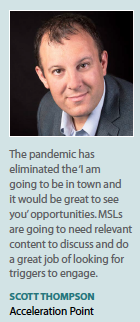
Dr. Goldberger expects to see a more rapid uptake of digital technologies and data visualization resources to provide HCP education. “Additionally, we may see increased demand for assisting with patient education programs, and there could be a role for MSLs to play there,” she says.
Dr. Winter-Sperry says the role of the MSL will continue to evolve and require new skills and backgrounds along with it. “This will be more of an evolution versus a revolution, but one thing that is for sure, it’s a new reality,” she says. “The healthcare industry is a dynamic ecosystem. New technology will continue to drive change and expand the possibilities. Data and insights will help us to learn more about what, where, and when our TLs want to interact with their MSLs and how to better individualize and enrich the engagement experience and relationship.”
Even if MSLs continue to be confined to virtual interactions, Mr. Melucci sees nothing but growth for the sector.
“I think that, just like us, the physicians are getting used to this virtual world,” he says. “I believe they will want to spend the little time that they have in a one-on-one setting with a colleague that they can relate to on a scientific level.”
Mr. Gupta foresees more innovations in MSL interactions with HCPs and KOLs. “Because virtual mode is more accepted by HCPs and they don’t just accept it, but value it ultimately,” he says. “As a result, MSLs will be able to bring other stakeholders into the mix to talk to the HCPs. MSLs will leverage platforms for on-demand and omnichannel kinds of content for the HCPs, and they will generally enable a higher degree of collaboration in the spirit of making the engagement more impactful for KOL and HCP.”(PV)
~~~~~~~~~~~~~~~~~~~~~~~~~
Getting More Social
As MSLs have switched to virtual means of engaging HCPs and KOLs, social media has become an increasingly useful tool — one that some of our experts say is being underused.
According to Bruno Larvol, founder and CEO of Larvol, there is an increasing need for MSLs to understand and get involved on social media. “A growing segment of rising stars in the medical community are sharing candid insights and building genuine connections on platforms like Twitter,” he says. “While MSLs may be hesitant to mix personal and professional on social media — and compliance may have some strict rules around it — those who have started to practice active social listening are surely ahead of the game.
“For instance, to support our customers in this growing need, we’ve developed a new social listening platform specifically focused on these digital opinion leaders in oncology,” he continues. “We can track the top voices in oncology on Twitter — currently around 1,500 verified oncologists — and rank their influence based on both online and offline activity. We then add a layer of sentiment analysis to reactions by each oncologist to trending news in oncology.
“I believe MSL teams in the future will need this level of social listening to identify influential HCPs and engage effectively with them on social media,” he concludes.
Michael Melucci, med ed lead at Ogilvy Health, also thinks social media is becoming an ideal channel for physicians to get information. “We know that a lot of third-party channels and social media are being used,” Mr. Melucci says. “And MSLs can play a huge role in helping to craft what those communications are. Again, the more that a pharma company can use the internal medical experts and scientific staff to craft these messages, the quicker the messages get out there.
“We all know the challenges associated with getting KOLs on board,” he adds. “They’re busy, especially those who are both teaching in the university setting and also seeing patients on a regular basis. Being able to tap MSLs, the people with the right brand experience and, at times, more knowledge of the product than those outside of the organization, proves invaluable for delivering communications within the social media environment.”
Mr. Larvol says the next year will bring more recognition of the importance of social media. “Most MSLs are still not taking advantage of this direct line to HCPs, and most pharma teams are still developing their social listening strategies,” he says. “I think this will be the biggest shift in the coming year.”
Eliav Barr, M.D., senior VP, global medical and scientific affairs at Merck, agrees the sharing and seeking of scientific information, perspectives, and commentary through social media will continue to be a trend. “It will be important for the industry to adapt and collect insights from such public social media sites as Twitter,” Dr. Barr says.







